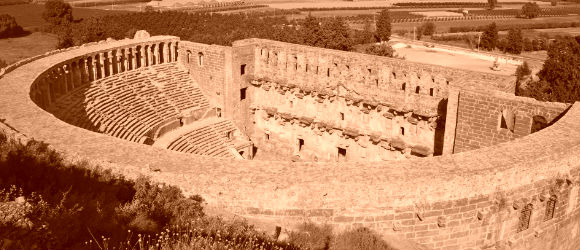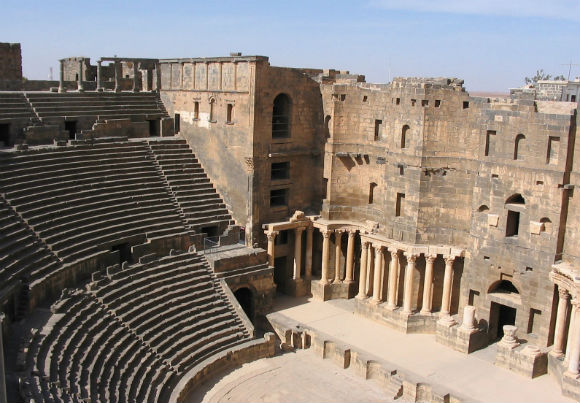Aspendos was an ancient Greco-Roman city in Antalya province of Turkey. It is located 7 kilometres (4.3 mi) northeast of central Serik.
Aspendos was an ancient city in Pamphylia, Asia Minor, located about 40 km east of the modern city of Antalya, Turkey. It was situated on the Eurymedon River about 16 km inland from the Mediterranean Sea; it shared a border with, and was hostile to, Side. According to later tradition, the (originally non-Greek) city was founded around 1000 BC by Greeks who may have come from Argos. The wide range of its coinage throughout the ancient world indicates that, in the 5th century BC, Aspendos had become the most important city in Pamphylia. At that time the Eurymedon River was navigable as far as Aspendos, and the city derived great wealth from a trade in salt, oil, and wool.
Aspendos did not play an important role in antiquity as a political force. Its political history during the colonization period corresponded to the currents of the Pamphylian region. Within this trend, after the colonial period, it remained for a time under Lycian hegemony. In 546 B.C. it came under Persian domination. The face that the city continued to mint coins in its own name, however, indicates that it had a great deal of freedom even under the Persians.
In 467 B.C. the statesman and military commander Cimon, and his fleet of 200 ships, destroyed the Persian navy based at the mouth of the river Eurymedon in a surprise attack. In order to crush to Persian land forces, he tricked the Persians by sending his best fighters to shore wearing the garments of the hostages he had seized earlier. When they saw these men, the Persians thought that they were compatriots freed by the enemy and arranged festivities in celebration. Taking advantage of this, Cimon landed and annihilated the Persians. Aspendos then became a member of the Attic-Delos Maritime league.
The Persians captured the city again in 411 B.C. and used it as a base. In 389 B.C. the commander of Athens, in an effort to regain some of the prestige that city had lost in the Peloponnesian Wars, anchored off the coast of Aspendos in an effort to secure its surrender. Hoping to avoid a new war, the people of Aspendos collected money among themselves and gave it to the commander, entreating him to retreat without causing any damage. Even though he took the money, he had his men trample all the crops in the fields. Enraged, the Aspendians stabbed and killed the Athenian commander in his tent.
When Alexander the Great marched into Aspendos in 333 B.C. after capturing Perge, the citizens sent envoys to him to request that he would not establish that he be given the taxes and horses that they had formerly paid as tribute to the Persian king. After reaching this agreement. Alexander went to Side, leaving a garrison there on the city’s surrender. Going back through Sillyon, he learned that the Aspendians had failed to ratify the agreement their envoys had proposed and were preparing to defend themselves. Alexander marched to the city immediately. When they saw Alexander returning with his troops, the Aspendians, who had retreated to their acropolis, again sent envoys to sue for peace. This time, however, they had to agree to very harsh terms; a Macedonian garrison would remain in the city and 100 gold talents as well as 4.000 horses would be given in tax annually.
In 190 BC the city surrendered to the Romans, who later pillaged it of its artistic treasures. Toward the end of the Roman period the city began a decline that continued throughout Byzantine times.
Aspendos,



The star of Aspendos is the ancient Roman theatre that is almost completely intact. This alone is really worth your visit.
However there is more! Right next to the entrance there is also the possibility to go to the top of the hill, where the ruins of the former Akropolis with the basilica, nympheum, a fountain and several other buildings…
The theater is in great shape, big, impressive. The entrance cost is totally fine and you can get pictures with gladiator. It can be done in an hour and you will keep good memories of it. Also recommended with kids
well worth a visit. great walk around and plenty of bazaars outside of entrance to buy soveneirs.
Hearing about this place was fascinating, i'd never set foot in such a place before.
You can get to the very top of the theatre, just be prepared for some steep steps. I'm aware they still use it today for open air shows – i'm a little bit gutted we weren't able to see this during our time there. If…
Amazing to see so much history so well preserved.
This Theater has been preserved with its 15,000 capacity from its Greco-Roman history in Antalya province of Turkey. Perfect acustics with perfect view from its old stairs and dungeons . This the most important historical theater in Turkey and definitely a place to must seen. Have a great time. If you have a great soprano sound don't hesitate to taetbit…
had a trıp to antalya ıt only took 40 mıns from the hotel and ıt was so nıce the cıty was out of thıs world …
I had visited this place in September 2011 while visiting Antalya and it was an awesome experience. The structure was remarkable, marvelous and worth visiting as you can just sit there and visualize plays / performances of roman times. The aura there is magnificent and am sure the live performance there would have been an amazing experience. The minor details…
Like the previous review from Canmom, I was surprised there were not a lot of reviews for this amazing theater from ancient times. I read that this is one of the most well preserved Roman theaters and I beleive it. From Side we took a bus tour to Aspendos & Perge. I love Turkey because there are so many great…
While staying in Side, we rented a car for the day and drove to Aspendos. Definitely recommend this over a bus tour! A two-story Roman aqueduct is also near by. Don't miss it!